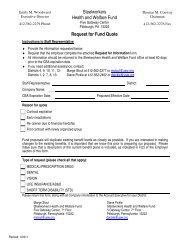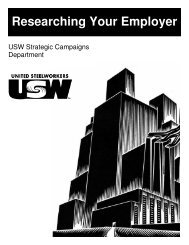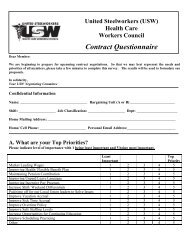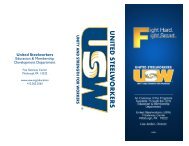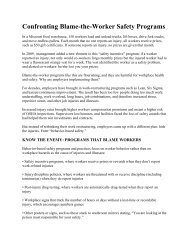Union Approach to Health and Safety: - United Steelworkers
Union Approach to Health and Safety: - United Steelworkers
Union Approach to Health and Safety: - United Steelworkers
Create successful ePaper yourself
Turn your PDF publications into a flip-book with our unique Google optimized e-Paper software.
discourage workers from reporting injuries, illnesses <strong>and</strong> hazards. These<br />
programs, policies <strong>and</strong> practices blame workers who have (or report) an injury for<br />
committing “unsafe acts” <strong>and</strong> engaging in “unsafe behaviors”. “Blame-the-worker”<br />
or behavioral safety approaches include such practices as “safety incentive”<br />
programs that offer rewards <strong>to</strong> workers who don’t report injuries; injury discipline<br />
policies that threaten <strong>and</strong> deliver discipline <strong>to</strong> workers who do report injuries; <strong>and</strong><br />
behavioral observation programs that take the focus away from hazardous<br />
conditions, including work organization hazards such as production pressures,<br />
lack of staff, work overload, <strong>and</strong> long work hours – <strong>and</strong> blame workers for being<br />
inattentive or working carelessly if they suffer injuries. Workers <strong>and</strong> unions need<br />
<strong>to</strong> eliminate these blame-the-worker schemes <strong>and</strong> instead focus on identifying<br />
<strong>and</strong> eliminating the real hazards that are causing injuries <strong>and</strong> illnesses.<br />
Addressing work organization hazards would include, for example, increasing<br />
staffing levels, providing job security, prohibitions or limits on m<strong>and</strong>a<strong>to</strong>ry<br />
overtime, shorter work shifts, job training, <strong>and</strong> reasonable workloads <strong>and</strong> pace of<br />
work. Solutions <strong>to</strong> these problems come from workers <strong>and</strong> unions having a<br />
greater say in how work is organized <strong>and</strong> restructured, how technology is used,<br />
<strong>and</strong> the policies <strong>and</strong> practices employers want <strong>to</strong> impose on the workforce.<br />
<strong>Approach</strong>es that unions can use include:<br />
Collective bargaining<br />
<strong>Union</strong>s have successfully negotiated language in contracts <strong>to</strong> require minimum<br />
staffing levels, limited or prohibited m<strong>and</strong>a<strong>to</strong>ry overtime, reduced production<br />
quotas, put limits on the pace of work, m<strong>and</strong>ated rest breaks, <strong>and</strong> developed<br />
safety <strong>and</strong> health programs that are focused on finding <strong>and</strong> fixing hazards rather<br />
than blaming workers.<br />
The AFL-CIO has a fact sheet on its web site with examples of contract language<br />
that put some limits on the employer’s use of m<strong>and</strong>a<strong>to</strong>ry overtime:<br />
http://www.aflcio.org/issues/safety/issues/otexamples.cfm<br />
Mid-term bargaining campaigns<br />
For unions with bargaining rights, the right <strong>to</strong> bargain is continuous (not just<br />
granted at contract expiration time). Employers are prohibited from making<br />
unilateral changes in wages, hours, or conditions of work (including health <strong>and</strong><br />
safety) without notifying the union about the changes <strong>and</strong> giving the union an<br />
opportunity <strong>to</strong> bargain over those changes. Employers must also bargain over<br />
the impacts of changes they make if the changes impact working conditions.<br />
Check the fact sheet linked below from the AFL-CIO web site that provides some<br />
additional information on mid-term bargaining:<br />
http://www.aflcio.org/issues/safety/issues/upload/injury_policies.pdf







